Chemical peeling at home is a great way to achieve perfect skin at no extra cost, eliminate problems with acne, blackheads, and delay skin aging. By applying a special composition filled with one or more acids to the face, you can correct skin imperfections. When choosing home peels over salon peels, it is important to consider the risk of complications. Even a minor error in the procedure and exceeding the concentration of the product will leave unpleasant consequences after cleansing.
What is a chemical peel?
Our skin is made up of many cells. The life of each of them is short-lived, only 28 days. If in youth the skin is able to independently get rid of dead cells and replace them with new and elastic ones, then with age this process slows down, and non-working particles accumulate, forming layers. Such accumulations worsen the condition of the skin, clog pores and prevent the flow of nutrients and oxygen into the epidermis. It is at this moment that you should discover what peeling is.
Dead cells are “weights” of the skin; they weaken the internal framework of the integument and interfere with the normal functioning of other, healthy cells. The main task of cosmetology and peeling is not only to eliminate these “weighting agents”, but also to minimally injure the skin.
Chemical peeling is the best way to quickly and efficiently cleanse the skin, but it uses aggressive components (concentrated acids, alkali).
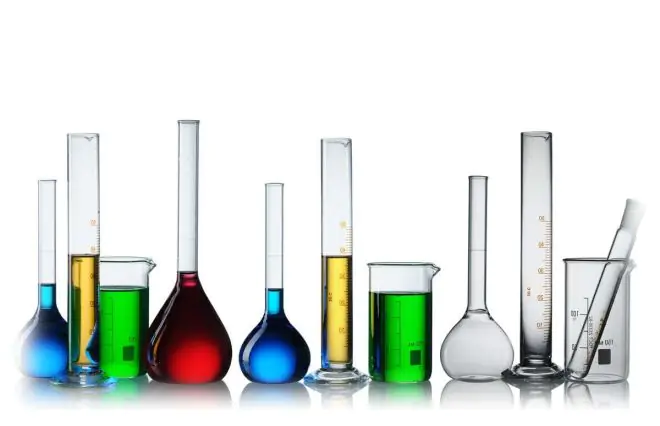
The essence of chemical facial peeling is quite simple: an acidic composition is applied to the face, which burns out the top layer of cells. Damage to the integument causes active regeneration and renewal of fibers. New fabrics differ from previous ones in elasticity and softness, and accordingly the face looks younger. In addition, “new” skin easily absorbs beneficial components from skincare products, thereby increasing its effectiveness.
What types of exfoliation are there?
There are several classifications of chemical facial peels. This is influenced by the degree and depth of acid exposure, as well as the composition of the product used (exfoliant).
Based on the depth of impact, facial skin peels are classified as superficial, medium and deep.
- Superficial peels are the easiest and most gentle procedures, because chemical exposure is limited to the upper layers of the epidermis. They are easily tolerated and rarely cause complications.
- Medium peels are a more serious intervention; the chemical ingredient affects the deeper layers of the skin. This procedure is very stressful for the skin, but the end result significantly exceeds expectations. After a mid-peel, the skin needs good support and high-quality post-peel care. The speed of fiber recovery and the ease of the rehabilitation period depend on this.
- Deep peeling is comparable in effectiveness even to surgical intervention. Acids affect all layers of the epidermis, right down to the reticular dermis. The slightest violation in performing cleansing. The lack of professionalism of the performer and failure to comply with the requirements for caring for damaged fibers can lead to serious complications and even residual scars, discolored spots on the face and other complications.
Chemical peeling of the face at home is recommended to be done only superficially; in rare cases, deeper effects are allowed. Deep peeling at home is impossible. Such chemical cleaning requires sterile conditions and high professionalism.
Based on the composition of the acid exfoliation product used, they are divided into single-acid and multi-acid.
- Multi-acid peels allow you to have a comprehensive effect on the skin, strengthen epidermal cells, normalize their functioning and the functioning of the sebaceous glands, moisturize and whiten. Each of the acids used makes its contribution to improving the quality of the skin, so after such procedures the face looks fresh and glows with health.
- Mono-acid products are recommended for use when the problem is pronounced, in order to eliminate it. For example, to combat acne, dry or oily skin, against the first signs of aging or skin pigmentation.
For home chemical peeling, the following acids are considered the safest, but at the same time highly effective:
- glycolic;
- dairy;
- retinoic;
- apple;
- pyruvic;
- lemon;
- salicylic;
- trichloroacetic and others.
The choice of acid for exfoliation depends on your own preferences, the condition of the skin and the degree of the problem. But in any case, before doing facial peeling at home using aggressive components, it is recommended to visit a cosmetologist.
Pros and cons of the procedure
Chemical peeling for the face has proven its effectiveness with unambiguous recognition from women and men. This is the most popular procedure in beauty salons.

Today, cosmetic companies offer those who cannot visit a beauty salon to perform it at home. For this purpose, separate, safer acid compositions have been created. Using them according to the manufacturer's recommendations, you can achieve excellent results.
The main advantages of home acid peels:
- There is no need to wait for an appointment with a cosmetologist, find time to visit a beauty salon, and even postpone your own plans. At-home chemical peels can be done at a time convenient for you.
- Financial savings. For chemical peeling at home, you can use ready-made cosmetic products and available products (fruit juices, aspirin, inexpensive pharmaceutical drugs). There is no need to overpay for the services of a professional.
There are also negative aspects of home cleansing:
- High risk of harming yourself due to insufficient experience in cosmetology. An error in choosing an acidic product, improper exfoliation and exceeding the exposure time can negatively affect the skin and cause complications.
- Systematic implementation is required. One procedure of home peeling with acids will not provide the same result as in a beauty salon. This is due to the lower percentage of acidity of the composition. To achieve a significant effect, be patient.
Chemical peeling at home is not able to eliminate significant skin problems, but it will perfectly complement facial care, delay the earlier appearance of wrinkles and sagging skin, partially correct existing imperfections and prevent their deepening in the future.
Indications and contraindications
It is recommended to carry out home facial peeling with acids at the first signs of skin aging. Indications for chemical exfoliation include:
- grayness, dullness of the epidermis;
- flabbiness, decreased natural tone;
- loss of elasticity of soft tissues, their sagging on the cheeks;
- frequent single rashes, acne and comedones;
- clogged and enlarged pores, blackheads on the face;
- first facial wrinkles;
- oily skin shine.
Before doing facial peeling with chemical compounds, consult a specialist to see if it can be done and how to do it correctly, without complications. During the consultation, the cosmetologist will examine your skin for contraindications.
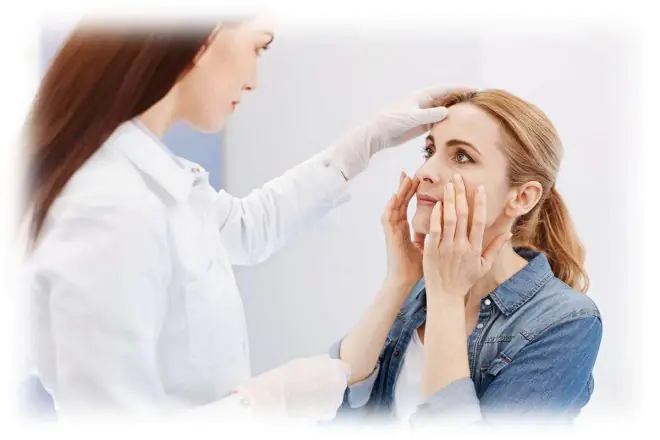
It is unacceptable to perform facial peeling at home in the following cases:
- there is an allergy to the components of the product;
- for ulcers, wounds on the face, as well as for exacerbation of acne;
- there is herpes on the face or there are oncological tumors, papillomas;
- there is inflammation in the treated area;
- for disorders of the nervous system and severe disorders of any of the body systems;
- during exacerbation of chronic diseases:
- the patient feels unwell and has a fever;
- during pregnancy and lactation;
- at an early age (up to 18 years).
It is recommended to postpone the procedure during menstruation or when taking hormonal medications. During this period, the effect may be unexpected or completely absent.
Safety precautions for home cleaning
How to do peeling correctly so as not to harm yourself and complicate the situation even more? It is difficult to predict all the subtleties and possible questions when performing cleansing, but the basic rules are worth discussing:
- Before exfoliating at home for the first time or when using a new composition, be sure to test for individual sensitivity to the product used.
- The preferred time for peeling is late autumn and winter. The sun's rays at this time have less impact on the skin, especially with weakened protective properties.
- When choosing an exfoliation technique and composition, rely on your skin type, study the comments on the product, and warnings for use.
- The peeling product is applied evenly in a thin layer. Do not touch the area near the eyes, lips, so as not to dry out the fine fibers.
- Carefully read the instructions for the product before using it for chemical peeling.
- The action of acids may cause a slight tingling sensation, but there should be no pain or burning sensation. If they appear, immediately neutralize the effect of the acid and wash off its particles to avoid burns.
- It is not safe to perform deep facial peels at home, even if they are less intense than in a salon.
- Home skin cleansing, like salon peeling, is carried out in courses, but not more than once every 10–14 days.
- Acids have an aggressive effect on the epidermis, after which the fibers are damaged and weakened, so touching your face with your hands in the first days is strictly not recommended. To moisturize the skin, you can use sprays and thermal water.
- Cosmetics for skin care after the procedure should not contain acids, fragrances, chemical components and abrasive particles. Only soft, natural products will be beneficial for the skin during the recovery period.
- Any mechanical impact on the integument after cleaning, stripping and scrubbing is unacceptable. This way you will not speed up the peeling of old fibers, but will provoke the formation of scars.
Be careful, low-quality, expired products cause allergies and irritate the skin. It is better to buy peeling ingredients or finished preparations at a pharmacy or from a representative of the manufacturer. At the market and in dubious retail outlets, storage standards are often not observed, as a result of which the products quickly deteriorate.
Popular acid attack methods
Almost all superficial exfoliations performed in a beauty salon can be performed at home without any problems. Cosmetic companies have taken care of their customers and offer separate product lines for home cleansing. Inside each preparation there are instructions with a detailed description of how to do peeling correctly.
Let's consider several popular and worthy methods for home use.
Jessner Peel
One of the most popular acid procedures in modern cosmetology is yellow peeling or Jessner peeling. The composition for facial exfoliation includes several acids at the same time (lactic, salicylic and resorcinol). Their complex action deeply cleanses the skin, normalizes metabolic processes, activates collagen synthesis and prevents the appearance of pimples and blackheads on the face.
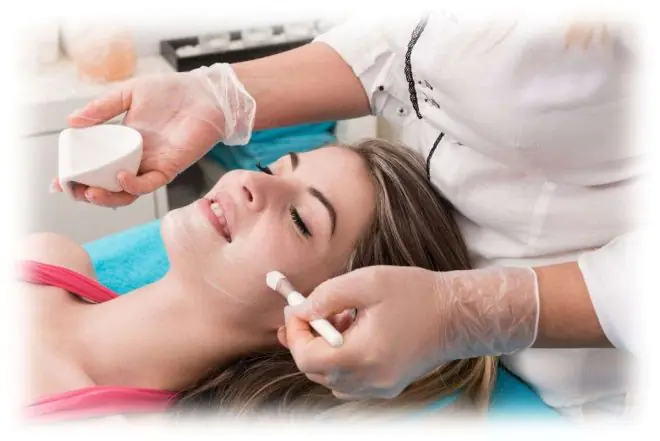
The full course of this type of exfoliation is conditionally divided into 3 stages:
- Deep cleansing and acceleration of intracellular processes.
- Rejuvenating effect, correction of facial surface relief.
- Fights extensive acne, deep wrinkles and age-related defects.
Each stage differs in the number of layers of application of the peeling agent and, accordingly, the depth of impact on the skin. However, the algorithm of actions is the same:
- Cleanse your face of oil and dust.
- Apply an exfoliant.
- Neutralize the acid.
- We remove the remaining acid preparation.
- Soothe the skin with moisturizer.
For the first stage, one layer is enough, for the second - two and for the third - three. Each subsequent layer is applied 5 minutes after the previous one. For patients with sensitive skin, the third layer is applied after a short period of time to prevent the appearance of wounds on the face.
Skin care after peeling is an equally important stage of the procedure. To avoid unpleasant marks on your face from acid exposure, adhere to the following rules:
- After exfoliation, wash with acidified water. Movements should be as soft as possible, non-traumatic;
- do not peel off peelings and crusts formed after a chemical burn, wait for their natural rejection;
- do not visit the bathhouse, solarium, sauna and swimming pool, postpone physical activity and sports until the skin is completely restored;
- For a month, avoid sunbathing, avoid direct rays of the sun;
- use sunscreen cosmetics every day for 3-4 months to prevent pigmentation from appearing on your face;
- do not use decorative cosmetics in the first 7–10 days;
- Do not use cosmetic products containing alcohol, aggressive chemical additives, or fragrances until the skin is completely restored.
Milk peeling
Lactic acid is contained in small quantities in the cells of the epidermis, so the cleansing technique of the same name is easily accepted by the skin, as a rule, without complications and lengthy rehabilitation. Let's look at how to do a chemical peel with lactic acid at home:
- 2 weeks before the planned cleansing, postpone sunbathing, and add a cream with a small amount of lactic acid to your daily care.
- Check how the skin reacts to the acidic composition: apply a little product to your wrist and wait for the reaction. Severe burning, pain and irritation are unacceptable.
- Cleanse your face with tonic or cleansing gel.
- Apply a diluted milk solution (lactic acid concentration should not exceed 10%). Do this with cotton swabs in parallel stripes from the forehead to the chin. It is important to distribute the composition evenly so as not to burn out individual areas.
- For the first procedure, limit yourself to 1 minute of exposure to the skin, then increase this time to 3 minutes.
- To neutralize the effect of the acid, treat your face with a weak alkaline solution (1 teaspoon of baking soda per 200 ml of water). Rinse off any remaining medication with plenty of water.
- Moisturize your face with cream.
Carry out the next cleansing procedure at least 7–10 days later. In general, the course of peelings is up to 5 procedures.
The main rule of the rehabilitation period is that you cannot use products containing retinol, and in the first days, fatty creams are also unacceptable. Otherwise, the recommendations are general: no thermal effects (baths, saunas, compresses, physical activity) and intensive hydration of damaged tissues.
Glycolic peeling
This type of cleansing is safe and hypoallergenic. The procedure allows you to improve metabolism in epidermal cells, smooth out wrinkles and folds on the face, even out your complexion and eliminate acne problems. Visible changes will become noticeable after just a few procedures.
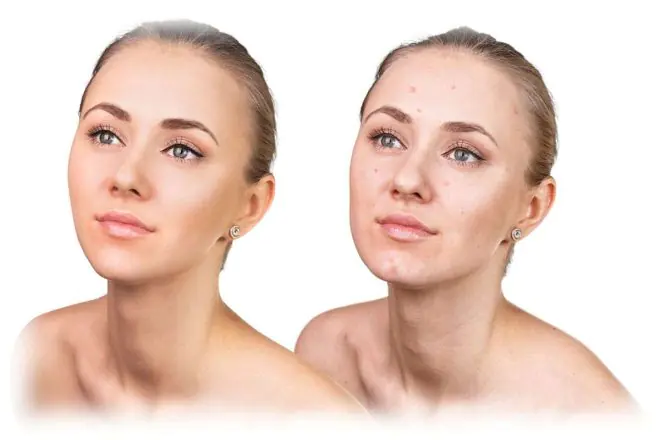
This type of exfoliation will be useful at 25 and 45 years of age. Glycolic acid with a concentration of 10–15% is used for cleansing.
Glycolic acid peeling is performed in the following order:
- The face is cleaned of dust and makeup particles.
- To degrease the skin, the face is additionally wiped with a lotion based on glycolic acid (5%).
- An exfoliant (glycolic acid up to 15%) is applied to the skin in an even, thin layer. Wrinkles and problem areas can be re-treated. Use cotton swabs to apply the product. Start peeling from the forehead area, gradually moving down to the chin. It is better not to touch the sensitive area around the eyes, eyelids and lips.
- After applying the product, wait a while for the ingredient to take effect. Then apply a neutralizing gel. Rinse off the remaining acid composition with warm water.
- Secure the result with a natural nourishing mask and moisturizer.
Cosmetologists recommend carrying out the procedure in courses (up to 10 sessions) with an interval of 1–1.5 weeks.
Attention! Do not increase the acid concentration above 15% to avoid causing a severe chemical burn. For more pronounced results, contact a specialist, because doing deep peeling at home is very dangerous.
Alternative home cleaning options
Effective peeling can be done using available products. Their recipes are simple and do not require long preparation. Let's look at the best of them.
Aspirin for facial cleansing
This type of cleansing is suitable for problematic and oily skin. After the first session, oily shine will disappear, pores will be cleaned, and acne will become less noticeable and inflamed. All this is thanks to the antibacterial and drying properties of aspirin.
To prepare the peeling solution you will need:
- aspirin (1–2 tables);
- 1 tsp. honey;
- 1 tsp. cooled boiled water;
- egg yolk.
To perform peeling, follow the following sequence of actions:
- Grind the aspirin and dissolve it in water.
- Then add the remaining ingredients to the mixture. Stir the mixture thoroughly.
- Distribute the prepared composition onto the face area like a regular mask. To do this, use a brush.
- After applying, leave the mixture on your face for 5 minutes.
- The product is removed with a cotton pad soaked in warm water or a weak alkaline solution. Do this delicately so as not to damage the skin.
- Follow with a light moisturizer.
Lemon juice instead of chemicals
You can use lemon to remove dirt, dead cells and whiten your skin. Lemon peeling is performed in this order:
- Squeeze the juice from the lemon and strain it.
- Soak a cotton pad in the concentrate, and then wipe your previously cleansed face with it. Do not apply the composition around the eyes, lips or eyelids.
- After 10–15 minutes, wash with warm water.
- Moisturize your face with cream.
Attention! Do not use citric acid for cleansing, only lemon juice.
The procedure is simple but effective. In addition, lemon juice whitens the skin, fills cells with nutritional components, vitamins, normalizes metabolic processes and skin regeneration.
For home peeling, you can use any fruits and berries. They will fill the epidermal cells with life-giving elements and will not harm. Those with dry skin types are recommended to use softer peels with kefir (it contains a large amount of lactic acid). Remember, the secret of long youthful skin lies in high-quality and timely care, which can be provided even at home! Exfoliating your face, body, and hands at home is convenient, affordable and very useful!
Chemical peeling is one of the most popular and effective facial procedures used in beauty salons. This is understandable, because this procedure has a stunning effect on the skin: eliminates blemishes, increases skin tone, improves complexion, etc. Unfortunately, not every girl can afford a salon chemical peel. In this case, there are special products that can become a worthy replacement for it at home. They will be discussed further.
Procedure
Chemical peeling is a simple procedure that is loved by many women. But before you try it for yourself, it’s worth learning more about it.
Features of application
For chemical peeling, solutions of fruit acids are used, as well as chemicals that effectively remove dead skin layers. Despite the fact that home peeling solutions are significantly inferior in composition to salon preparations, they can cause significant harm if used incorrectly. That is why, before using any products, consult a dermatologist and cosmetologist.
Peeling effectively helps with the following skin problems:
- oily skin with enlarged pores. Peeling removes sebaceous plugs and tightens pores, normalizes oil production by the skin;
- loose skin. Peeling perfectly tightens the skin;
- scars left by acne and pimples. Peeling makes them less noticeable;
- pigment spots become lighter;
- prevention of aging. Occurs due to the activation of skin cell renewal processes.
Rules for the procedure
Whatever composition you choose for chemical peeling, the procedure is carried out according to a similar scheme. First, you should check the skin's reaction to the chemical composition that will be used. Apply some of the chemical to your palm and leave it on for a couple of minutes. Observe your sensations: if you feel a slight tingling sensation, this is a normal reaction, but if you feel a burning sensation or pain, the skin reacts negatively to the chemical composition of the peeling.
Before the procedure, you need to steam the skin. It is enough to place a damp hot towel on your face for a couple of minutes. 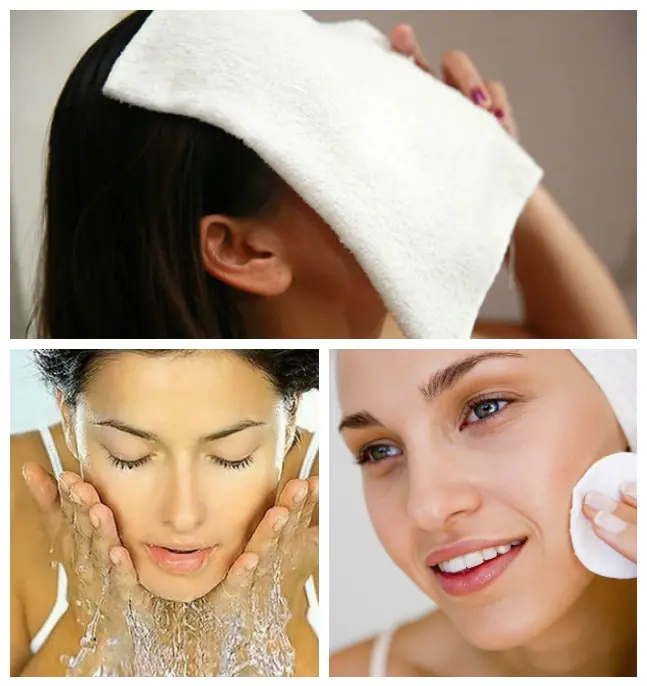
After this, you need to thoroughly wash your face with soap and cleanse it with a toner to remove residual oil and makeup. Now you can proceed directly to applying the chemical composition. How to do this correctly can be read in the instructions for the drug.
Contraindications for chemical peeling
Despite all the advantages of chemical peeling, it is not suitable for everyone. This procedure is contraindicated in the following cases:
- in the presence of skin diseases (acne, dermatitis, etc.)
- if there is rosacea (vascular network) on the face;
- with serious inflammatory processes on the skin;
- if your skin is too sensitive;
- for diseases of the cardiovascular system;
- in the presence of herpes in the active stage;
- during menstruation and menopause;
- during pregnancy and breastfeeding.
It is worth saying a few words about the frequency of chemical peeling. Firstly, you should not get too carried away with this procedure, otherwise you can damage the top layer of the epidermis. It is enough to deep clean your face once a week. Remember, when carrying out serious skin cleansing, it is not the speed of achieving the result that is important, but its quality and durability.
Effective products for chemical facial cleansing at home
Most often, several of the most gentle and at the same time quite effective means are used to cleanse the face, which are discussed below.
Peeling with calcium chloride
To carry out this peeling, you only need one product - calcium chloride. It can be freely purchased at a pharmacy. For one procedure, a 5 ml ampoule will be sufficient. The frequency of the procedure is no more than 1 time in 10 days. The concentration of the drug during the first procedure should be no more than 5%. With a normal reaction to the composition, over time you can increase it to 10%.
As with any drug, check your skin's reaction to the drug. If everything is fine, you can begin the cleaning procedure.
Using a cotton sponge, apply a thin layer of the product, then wait a couple of minutes for it to dry. After this, moisten the sponge again with the preparation and apply a second layer. Repeat the procedure several times. Usually 3-4 layers are enough, but if the skin is not very thin and there is no excessive burning sensation, you can increase the number of layers to 7-8. 
When the last layer has dried, you can begin to remove the mask. This process is carried out with rolling movements of the fingers, slightly lubricated with baby soap. The duration of withdrawal is individual in each case. You will feel it yourself. The main thing is not to rush, so as not to damage the skin. After removing the mask, gently rinse your face with warm water and then with cold water. This is necessary to soothe the skin and close the pores. Pat your face dry with a towel and apply nourishing cream to your skin.
Peeling with salicylic acid
Peeling with salicylic acid is carried out not in single “approaches”, but in a course. 5-6 procedures performed once every two weeks are enough. Using salicylic acid, you can perform superficial or mid-superficial peeling. 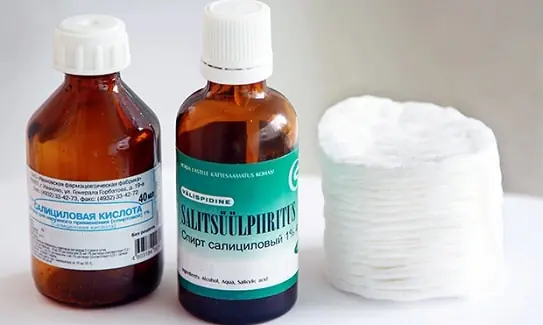
The first option is considered more gentle. The procedure should not last more than 20 minutes. To cleanse the skin, 20% salicylic acid is used. This option is ideal for those who have problematic or oily skin.
The second option is tougher. The procedure should last no more than 10 minutes. To cleanse the skin, 25-30% salicylic acid is used. This type of cleansing is more suitable for aging skin.
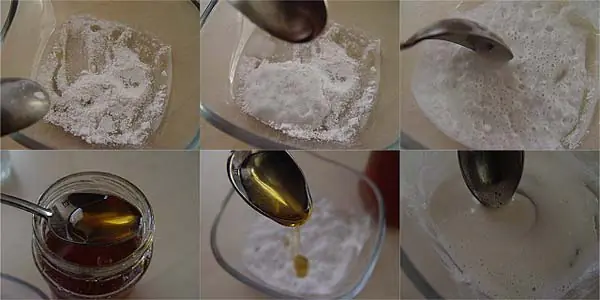
The skin should be prepared in advance for salicylic peeling. A couple of weeks before the procedure, you need to avoid visiting a bathhouse, sauna, etc. Before the procedure, the skin should be cleansed of makeup, fat and dirt. Wash with soap and apply any antiseptic to disinfect the skin.
Keep in mind that the skin must be completely clean. Otherwise, as a result of peeling, dirt particles will enter the pores and inflammation will occur.
The peeling mass should be applied very carefully and left for no more than 10 minutes. The time must be strictly observed. If you feel a burning sensation earlier, it is better to remove the mask immediately. Remove any remaining mask by washing with cool water. And as a final step, treat the skin with an antiseptic.
After the procedure, it is advisable to apply a moisturizer to your face, otherwise you may experience unpleasant skin tightness.
Peeling with lactic acid
You should be extremely careful with lactic acid, since the slightest mistake will be enough to damage the skin. So, first you need to cleanse the skin in the manner described in the previous peeling options. Then you can gently wipe your face with alcohol. It is better to apply a thin layer of nourishing cream or Vaseline to the most sensitive areas of the face (the area around the lips, the skin around the eyes).
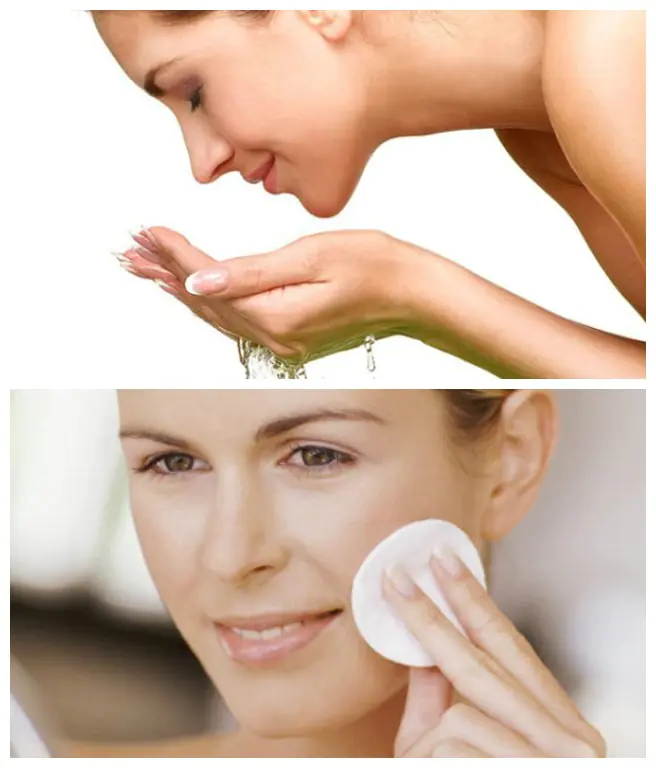
Now you can apply lactic acid to your face. Proceed in the following order: first the forehead, then the temples, after the cheeks, the nose and the last will be the chin. Leave the mask on the skin for no more than a couple of minutes. If you feel a strong burning sensation earlier, remove the mask immediately.
By the way, the mask is washed off in the reverse order of application. After the procedure, apply nourishing cream to your face. It is advisable to carry out the procedure no more than once a week. Peeling with lactic acid is carried out in a course of 8-10 procedures.
Skin care after a chemical peel procedure
In order not to harm your skin after chemical peeling, you must follow some rules that will help protect it from possible damage:
- Chemical peeling is best done in the autumn-winter period, when the sun is not so aggressive and comes out from behind the clouds much less often than in summer or spring.
- In the first few days after the procedure, it is better to avoid prolonged exposure to the sun, since during this period the skin will not respond well to exposure to ultraviolet radiation. If possible, it is better to use creams with ultraviolet protection.
- It is better not to engage in active physical activity for a couple of weeks after peeling.
- To cleanse the skin, you should use gentle cosmetics and wash your face only with warm water.
- If severe itching occurs, do not scratch the skin under any circumstances. In this case, you can take an antihistamine.
In general, chemical peeling cannot be considered a dangerous cosmetic procedure. But this is only if it is carried out according to all the rules. Otherwise, you can only worsen the condition of your skin. When deep cleansing your face, be careful, attentive and careful. Good luck!
Watch a video about chemical peeling
Peeling is one of the most popular procedures both in salons and at home. Refreshes the skin, slows down the aging process, minimizes pimples and age spots. We'll tell you how to choose products with a peeling effect.
- Features of facial peeling products
- Types of peeling products
- Rules for choosing peeling products
- Precautionary measures
- Cosmetics review
Features of facial peeling products
Translated from English, the word “peel” means “to remove the peel.” And the procedure itself is exfoliation:
dead epidermal cells (they are the main reason for the effect of dull “parchment” skin);
top layer of skin for visible rejuvenation.
Types of peeling products
by depth of penetration - superficial, middle, deep;
depending on the principle of operation - mechanical, chemical, hardware.
Only superficial mechanical and chemical peels are performed at home.
Mechanical
They contain abrasive particles of natural and synthetic origin of different sizes, shapes and hardness.
Natural: crushed fruit seed shells, ground coffee beans, crushed grape peels, microparticles of eggshells, pearls, loofahs, chitinous cover of crustaceans.
Synthetic: nylon powder, polyethylene particles, cellulose. Facial massage, carried out with the help of such abrasives, delicately cleanses only dead skin particles.
Mechanical peeling contains abrasive particles of natural and synthetic origin of different sizes, shapes and hardness. © iStock
Obviously, mechanical means include scrubs. The choice of scrub depends on the size of the particles: larger inclusions can injure dry, thin facial skin, in which case synthetic granules are preferable.
It is better to use the scrub in the evening, before bed, so that the skin more effectively absorbs the active ingredients of the night cream and can properly recover.
Chemical
These products contain:
hydroxy acids, for example, AHA (lactic, malic, glycolic, grape) and BHA (salicylic);
enzymes (papain, subtilisin) or retinol.
These substances weaken the connections between epidermal cells, promoting their exfoliation, and have a beneficial biological effect on the skin:
stimulate the work of epidermal cells;
improve skin color and texture;
increase its tone.
And now the actual types of peeling products.
Gommage. Ideal for any skin type, even sensitive. The product in the form of a cream is applied to the skin for 10–15 minutes and then washed off with water.
Film mask. It is applied to the face in a fairly thick layer, hardens and is removed along with the keratinized particles of the surface layer of the epidermis.
Exfoliating lotion. Use daily before bed after removing makeup.
Exfoliating serum. This relatively new product is intended for problematic (acne, rashes) or mature (wrinkles, loss of firmness, hyperpigmentation) skin. Contains a fairly high concentration of alpha hydroxy acids in combination with vitamins and antioxidants.
System for chemical peeling at home. Simulates peeling in a salon. As a rule, it consists of an exfoliating (acid-based) substance and a neutralizing cream.
Rules for choosing peeling products
In this matter, consider your age, skin type and the problems you want to solve.
Remember: when choosing a product with a high concentration of alpha hydroxy acids, consultation with a cosmetologist is required.
Age
After 20 years Scrubs, gommages, film masks, cleansing lotions are suitable. With regular use, they will keep your skin smooth, soft and fresh.
After 30 years slowing down the skin renewal process, signs of photoaging (in the form of hyperkeratosis and the first visible wrinkles) require formulas with a higher concentration of fruit acids. Exfoliating lotions and anti-aging serums will come in handy.
After 40 years and older, along with home remedies (anti-aging lotions, serums and masks), more intense peeling in a salon or clinic is recommended.
Today, exfoliant products increasingly combine mechanical and chemical exfoliation. © iStock
Skin type
For dry skin, lactic or citric acid is more often used, for oily skin - salicylic acid.
Problem
Acne. Regular use of exfoliating products allows you to cleanse the ducts of the sebaceous glands, reduce the number of comedones and rashes.
Hyperpigmentation. Products based on fruit acids lighten age spots and regulate the functioning of melanocytes.
Skin reactivity. For sensitive skin prone to irritation or redness, exfoliating products based on fruit acids are often not suitable.
Precautionary measures
Contraindications for chemical peeling:
inflammatory skin diseases in the acute stage;
individual intolerance to fruit acids;
hirsutism (increased hair growth);
Cosmetics review
Gel, scrub, mask “Clean skin 3-in-1”, Garnier
This product is intended for combination and oily skin. Contains eucalyptus extract, zinc and salicylic acid. It has triple effectiveness: it gently exfoliates the skin, reduces pimples and blackheads, and removes oily shine.
Blemish & Age Defense Serum, SkinCeuticals
Designed to correct imperfections and age-related changes. Contains dioic, glycolic, salicylic, citric acids. Evens out skin texture, reduces hypersecretion of sebaceous glands, and prevents post-inflammatory hyperpigmentation. To be used daily: apply 4-5 drops in the evening to the face and décolleté.
Night peeling >




